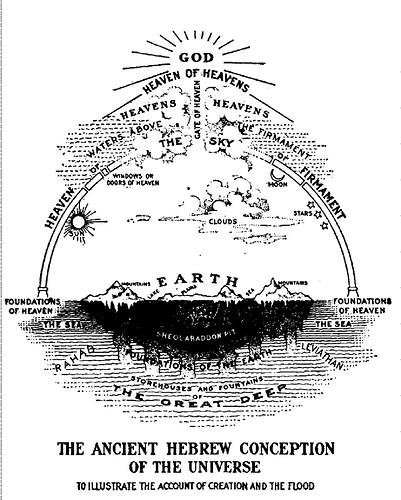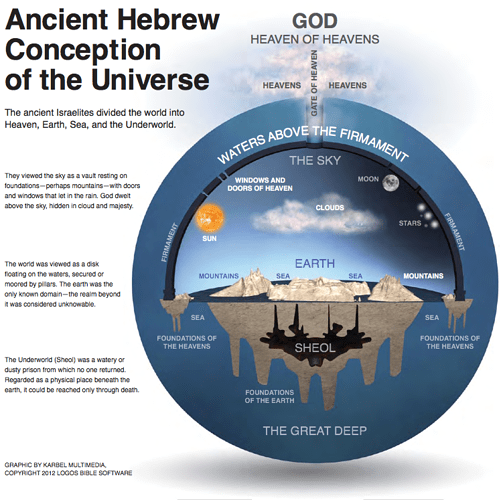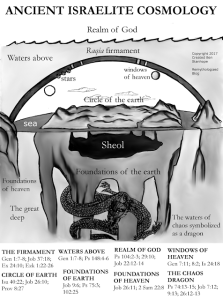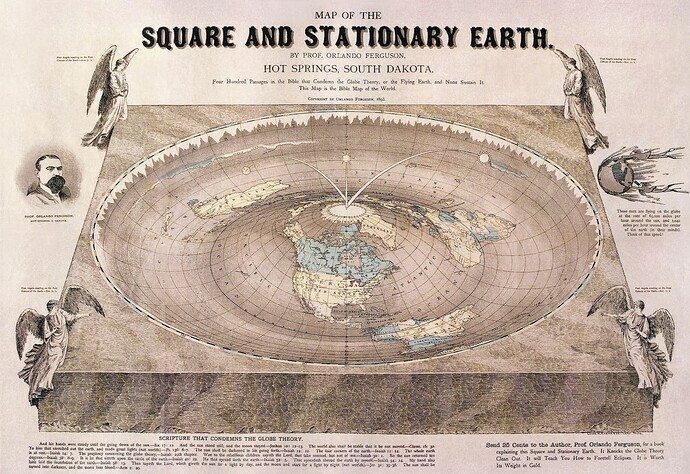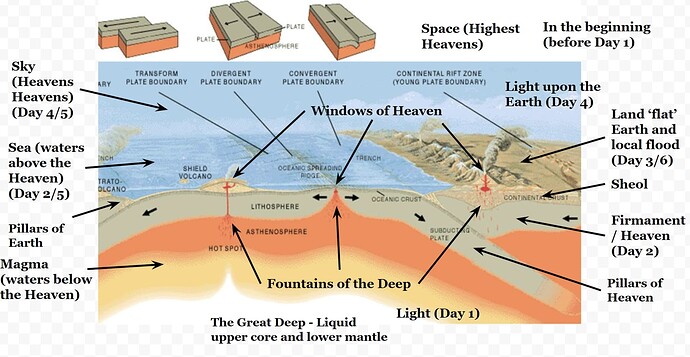-
Trivial pursuit: The Hebrew Conception Of The Universe.
-
Source: Ancient Hebrew Conception of Universe - National Center for Science Education (U.S.)
-
Source: “Ancient Hebrew Conception of Universe” - Faith Seeking Understanding, Charles Sigler
-
Source: Orlando Ferguson, Flat Earth Map
-
Bible Verses cited in Ferguson’s Map:
-
Modern Version of Flat Earth
-
That is really bad science fiction; it gets so much wrong!
“Waters” means “waters”, or at least a fluid that acts like water; it isn’t magma. The “pillars of Heaven” are not a subducting plate. The firmament is not underground, it is a solid dome over the earth-disk. The Sea is not the waters above. The “pillars of the earth” are not tectonic plates. Volcanoes are not the “windows of Heaven”. “Sheol” is not the continental crust.
So that diagram “doesn’t know what God was talking about”. In fact it looks like something a bored seventh-grader might have thrown together in the last three minutes before the school bus came.
The ancient Hebrews used various idioms, phenomenological language, and metaphors to describe their world not unlike how we do… all of these diagrams make the potential error of making something woodenly literal that, for all we know, none of them actually literally believed. (Not unlike if some future civilization made a chart of how we 21st century Americans believed in Geocentrism due to all the references they found to sunrise and sunset in all our newspapers…)
I’m always a bit cautious about this kind of thing ever since I read John Walton’s rather simplistic claim that the ancient Hebrews believed the sun and moon to exist in the same space as the birds, based on them using the same words and language for both… I don’t think it would take too long to think about it to realize that they probably noticed that birds always flew in front of the moon, never behind it, never bumping into it, never landing on it…
These diagrams similarly force a simplistic and literalistic perspective, based on idiosyncrasies of their language, and suggest they really literally believed that the clouds inhabit the same “space” as the sun and moon and stars… and that they literally believed that rain doesn’t come from clouds but from “doors” in the heavens. I find that utterly preposterous when I give it any thought.
Do we really think that no ancient Hebrew ever happened to notice that the clouds are always on THIS side of the moon and stars, and that the clouds never pass behind the sun, moon, or stars?
And we really want to believe that the ancient Hebrews never managed to make the connection between clouds and rain? They never noticed that it doesn’t rain when there are no clouds, and vice versa? They believed literally that rain came from these “doors of heaven” that let in the rain, and not from rainclouds? It isn’t just more likely that “floodgates of heaven” was a metaphor, and they may actually have recognized that rain came from rainclouds?
- Ask Seventh Day Adventist YECS where they believe the water came from that watered the earth and all vegetation on it before the Flood that raised Noah’s Ark.
The only science fiction is the ancient Hebrew concept. I am just connecting the outdated terminology with what we know today.
- Waters - H4325 mayim water; figuratively juice; by euphemism {urine} semen
It doesn’t just mean water but could just be something in a fluid state. Magma is a fluid or semi-fluid similar to semen.
- Job 26:11 The pillars of heaven tremble and are astonished at his reproof.
- 2 Sam 22:8 Then the earth shook and trembled; the foundations of heaven moved and shook, because he was wroth.
Well the only thing we can glean from scripture references is that the pillars (or foundations) of heaven move, shake or tremble, and has some relation to the earthquakes. Sounds like plate tectonics to me.
There is no solid dome over the earth and the Bible doesn’t say that is where the firmament is. The firmament is solid. It is what the earth and the waters above the firmament sit on.
-
Gen1:6 And God said, Let there be a firmament in the midst of the waters, and let it divide the waters from the waters. 7And God made the firmament, and divided the waters which were under the firmament from the waters which were above the firmament: and it was so. 8And God called the firmament Heaven. And the evening and the morning were the second day.
-
firmament - 7549: raqiya` from 7554; properly, an expanse, i.e. the firmament or (apparently) visible arch of the sky:–firmament.
-
7554: raqa` a primitive root; to pound the earth (as a sign of passion); by analogy to expand (by hammering); by implication, to overlay (with thin sheets of metal):–beat, make broad, spread abroad (forth, over, out, into plates), stamp, stretch.
Sounds like the laying down of all the rock strata, beaten down by time, floods, sediment, magma, etc.
-
Job 37:18 Hast thou with him spread out the sky, which is strong, and as a molten looking glass?
-
sky - from 7833; a powder (as beaten small): by analogy, a thin vapor; by extension, the firmament:–cloud, small dust, heaven, sky.
The sky is dust, powder? Sounds more like the earths crust being formed here. Inconclusive.
Interesting use of the word molten… something that will harden like metal or magma?
- molten - 3332: yatsaq a primitive root; properly, to pour out (transitive or intransitive); by implication, to melt or cast as metal; by extension, to place firmly, to stiffen or grow hard:–cast, cleave fast, be (as) firm, grow, be hard, lay out, molten, overflow, pour (out), run out, set down, stedfast.
- Gen1:9 And God said, Let the waters under the heaven be gathered together unto one place, and let the dry land appear: and it was so. 10And God called the dry land Earth; and the gathering together of the waters called he Seas: and God saw that it was good.
Magma gathered together unto one place (and could be caused by plate tectonics) would be pushing up on the land forming mountains, islands. In the second instance it could be the waters both above and below that are being called seas. Besides magma, there are also subterranean seas. The lake of fire could be magma from the deep.
Phenomenological experience is generally consistent with the cosmologies diagrammed above. If I were an ancient near eastern person, I would till a flat field and sail a flat sea, and not being a critical Greek, would fail to infer much from disappearing masts. So my world is flat. The Earth is right under my feet, everything else is far, so the Earth is at the center. Further, since you would feel it were it moving, the Earth is stationary. Follow water downhill, and you will always encounter the sea, so the world is surrounded by water.
This one is darned good in the image itself, though I would say “Waters” rather than “Sea” on the description, since “sea” was just one part of “the waters”. The small print around the diagram is more sketchy, especially the claim about the earth “floating on the waters”, which is a description drawn from (IIRC) the Sumerian version; Sheol as “watery” is also imported.
Yeah, that bugged me. Though “heaven” and “sky” use the same word, there’s a definite distinction since birds fly freely but the stars (except for “walking stars”, i.e. planets) marched in orderly fashion; also the stars are treated as heavenly beings while birds were definitely not so regarded.
The same objection arises here: they didn’t regard clouds per se as divine or heavenly though they could be used by Yahweh, but the stars were definitely in the heavenly realm.
Definitely by the time of the writing of the books of Kings as well as the Psalms they understood the connection between clouds and rain. It seems reasonable to suppose that before Abraham the concepts matched those of the surrounding culture, even to the time of Moses, but once Israel was in the wilderness marching in loops it was on its own cultural trajectory. So if this is pushed back to the time of the patriarchs Walton may have a point, but not once there was a people known as Israel.
Without going looking I’ll venture that for massive, monsoon-like rain was perceived as resulting from gates in the firmament since it was so heavy. In the Psalms, though, there is definite sign of metaphor involved.
In other words you’re trying to force ancient literature to be speaking in terms you prefer rather than its own. That entire diagram is nonsense; it makes a total hash of what the ancient words meant, let alone the worldview of the writer.
That the ancient Hebrew language had no word for if they even knew about magma.
That’s because you’re trying to make ancient literature speak your language rather than actually trying to read it as its original audience would have. Down through the centuries people have made the same error, trying to force the text to fit their concerns and their worldview, and a frequent result has been bad teaching.
“Solid dome” is what the Hebrew means; that it is over the earth-disk is known from God calling it “heaven”.
I don’t know what those numbers are, but that’s a really shallow set of possible translations. A רָקִיעַ is a beaten surface, as of metal, pounded out into a greater surface area. Whatever you’re relying on here is assigning meanings from a much later worldview and is thus reading into the text rather than reading from it.
So in your view heaven is made of rock?
So we have a solid sky again, like a cast-metal or beaten-metal mirror.
No, because the root for “sky” has to do with something beaten till fine, or something like it, which is why the noun tends to be used for clouds, both of the rain variety and of dust – and because the sky is not the ground.
You’re just making stuff up and calling it interpretation. Genesis does not speak in scientific terms, it speaks in terms of its ancient cosmology, and that cosmology has nothing to do with modern geology. By trying to force any ancient literature to speak in modern terms all you can get is a mess.
Besides which no one in the ancient near east sailed far enough from land to really notice the phenomenon!
Quite so. The main missing element is Sheol, but they inferred an underworld because clearly the sun in his barque or chariot went down in one direction and came up the next day from the other, so ‘obviously’ he had made a passage underneath the flat earth and its associated seas – and since the t’howm, the “deep”, was chaos and darkness then that must be where the dead went, besides the ‘fact’ that gods plainly lived in high places where the dead wouldn’t be welcomed.
But there are thin clouds that appear to be behind the sun/moon because the sun remains visible. So without knowing that the sun is a great distance away they well could have imagined clouds behind the sun/moon.
You have never been rained on when there wasn’t a cloud overhead? I have (while standing in full sun shine) but then I know upper level winds can blow rain out from under the cloud it falls from.
True enough, but far more commonly clouds are on the viewer’s side of the sun.
I almost mentioned that earlier. Just last week I was getting rained on when the nearest cloud was at least three miles away!
…and the Sun can be superior to the clouds but still contained within the firmament. It must be reasonably close, because you can feel it’s warmth, and you cannot feel the heat of a fire if it is too distant.
May I politely ask what is the point of all this? What relevance has it to our understanding of God? does it even help our understanding of Scripture?
All it seems to prove is that isolating verses or even whole chapters can produce false understanding.
Genesis 1 is not about how the Universe was made, or made up, it is about who made it. It also claims a single deity rather than things like the Sun and the moon having godly powers and influence.
Richard
- You may, but a complete answer that shows you all the dots that you need to be familiar with and that accurately connects those dots would be tediously long to compose and would involve (1) a thread which is now closed and (2) this thread which responds to a request made at the end of that thread.
- If you still want an answer to your question, then I suggest that you begin with:
(Is there a standpoint from which the creation days in Genesis 1 are described as 24 hours per day?)- Hello everyone,
I’m new to this forum and joined because I’ve been searching the internet extensively for an answer to my question. Despite my efforts, I couldn’t find search results that fully addressed my inquiry. My curiosity led me here in hopes of finding some clarity.
My question is about in the Young Earth viewpoints. I’m interested in understanding the Young Earth perspective. To approach this, I’ve set aside my knowledge of evolution but retained two key understandings:
- Hello everyone,
- If you still want an answer to your question, then I suggest that you begin with:
- The Earth rotates.
- Day and night occur simultaneously on different parts of the Earth.
- This thread was opened by a Moderator at an individual’s request made at the end of that previous thread.
Thank you.
My supplementary comments still stand.
But, perhaps, as a point of clarification the information you provided is relevant.
Richard
- That’s a tall horse that you’re sitting on.
- Reko Tom, who may be a Seventh Day Adventist and who is a self-acknowledged YEC, posed a question. During the course of responses, I offered a number of diagrams that represent, biblically, the Ancient Hebrew view of the Universe. @graph2vine added the final diagram. @St. Roymond critiqued the last diagram.
- There’s no “perhaps” to quibble about. Your “supplementary comments” are irrelevant and in vain.
Given we have diagrams of the “earth and heavens” as viewed by the ancients is it possible to just argue that the diagrams are also just “metaphors” and don’t reflect their actual beliefs?
I think from an ancient Hebrew concept we could call it a metaphor. It was an abstract concept to them not knowing where the ends of the earth were. Here is a metaphor:
In the beginning God created the heavens and the earth. It was a piece of cake. There was frosting both above and below the layers of cake which was soft and moist. And he called the cake heaven and the earth frosting. It lay flat against a plate with a fork poised above it.
But with a modern concept, we now know that God didn’t just create a piece of cake, but a whole cake. And after biting into it with the fork, we can confirm that it is indeed soft and moist. And while it was a piece of cake, it did still take an hour to bake.
I’m trying to show that both the ancient Hebrew concept and our modern concept are true at the same time. This shows inspiration with depth of understanding.
…maybe I should have said, In the beginning God baked the heavens and the earth. ![]() It certainly did start out as a ball of fire like the sun.
It certainly did start out as a ball of fire like the sun.
